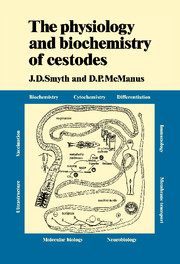Book contents
- Frontmatter
- Contents
- Preface
- Acknowledgements
- 1 The cestodes: general considerations
- 2 The adult cestode: special structural features relevant to its physiology
- 3 The adult cestode in its environment
- 4 The adult: general metabolism and chemical composition; lipid metabolism
- 5 The adult: carbohydrate metabolism
- 6 The adult: proteins and nucleic acids
- 7 The biology of the egg
- 8 Developmental biology of larvae
- 9 Development within definitive host
- 10 Cultivation of cestodes in vitro
- 11 Immunobiology of cestodes
- References
- Index
1 - The cestodes: general considerations
Published online by Cambridge University Press: 24 November 2009
- Frontmatter
- Contents
- Preface
- Acknowledgements
- 1 The cestodes: general considerations
- 2 The adult cestode: special structural features relevant to its physiology
- 3 The adult cestode in its environment
- 4 The adult: general metabolism and chemical composition; lipid metabolism
- 5 The adult: carbohydrate metabolism
- 6 The adult: proteins and nucleic acids
- 7 The biology of the egg
- 8 Developmental biology of larvae
- 9 Development within definitive host
- 10 Cultivation of cestodes in vitro
- 11 Immunobiology of cestodes
- References
- Index
Summary
General account
Cestodes represent a group of organisms which present many features of exceptional physiological interest. They are, for example, almost unique amongst parasites in that the adult worm occupies only one particular habitat, the alimentary canal, in one particular group of animals, the vertebrates. Moreover, the known exceptions to this generalisation occur in sites related to the alimentary canal – the bile duct, the gall bladder or the pancreatic ducts.
The only adult forms which occur in hosts other than vertebrates are members of the subclass Cestodaria, whose physiology is largely unknown (and is not considered here) and a few neotenic forms in oligochaetes (i.e. Archigetes).
The dominating morphological features of adult cestodes are: (a) an elongated tape-like body – a form elegantly adapted to the tubular habitat provided by the host gut; and (b) the absence of an alimentary canal, in either the adult or larvae. The latter feature is of major physiological importance, for it means that the external surface of the worm, which ultrastructural studies have revealed as a ‘naked’ cytoplasmic tegument unprotected by a resistant ‘cuticle’, has evolved as a metabolically active surface through which the transport of all nutrients into, and waste materials out of, the worm must take place. This characteristic makes the cestode tegument a superb model for membrane transport studies and, for these, several species, especially Hymenolepis diminuta, have been used extensively.
- Type
- Chapter
- Information
- The Physiology and Biochemistry of Cestodes , pp. 1 - 4Publisher: Cambridge University PressPrint publication year: 1989



